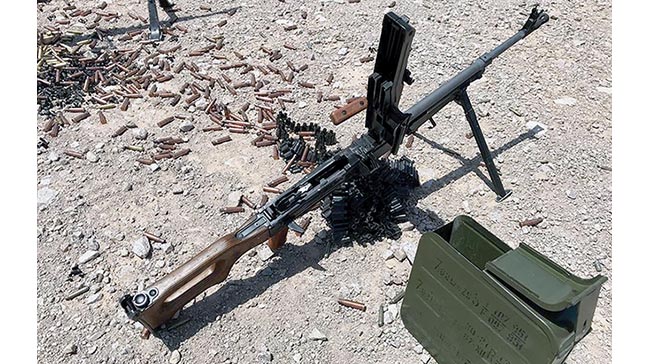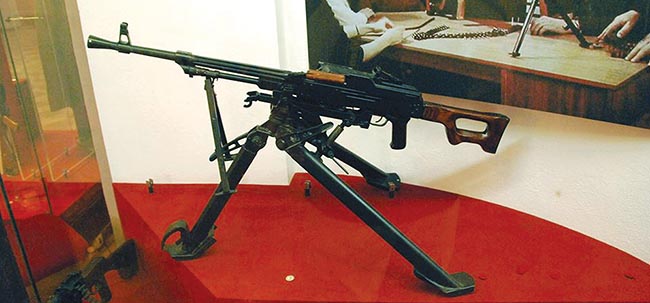ABOVE: Pro Gun Club PKM built by Rifle Dynamics on a VLTOR Weapon System receiver.
A common story in Eastern European warfighting development—the GAU (the Main Artillery Department) in Moscow learned a harsh lesson from the devastating effectiveness of the German universal machine guns deployed against the Soviet forces during the Great Patriotic War. The bureau looked to their own wide variety of machine guns of different make, model and capabilities and examined their individual shortcomings in the fierce combat against the invading fascists. In 1946, the GAU approved and issued the new Tactical and Technical Requirements (TTT) No. 3230, a mandate to create its own “universal machine gun” or “the single machine gun,” later commonly called “general purpose machine gun.” The design was to replace the M1910/30, SG-43, and even the recently adopted RP-46, and consolidate the Soviet machine gun inventories into a single streamlined production, deployment and training regime.
In the immediate years, many designers could not get traction past failed shop-room prototypes, including noted designer Grigory Nikitin. However, in 1953, Nikitin began work again, this time in collaboration with Yuri Sokolov to design their own “single machine gun” answer to the TTT mandate. The TKB-521 single company and battalion machine gun passed the TTT requirements on December 31, 1955, on the authority of the State Automobile Inspectorate. Finally, with a competent design in the running for state adoption, Nikitin began production development in 1955 and was ready for factory tests as early as 1956. State authorities recommended that Nikitin further refine his design before submitting to state trials, but not to worry, the machine guns of his potential competitors were moving slowly and had not passed the prototype phase. Nikitin addressed these design concerns by 1958, and the machine gun passed tests and received positive evaluations. Nikitin was allowed to begin modest serial production of a factory sample for military testing at the Kovrov Mechanical Plant. Documents suggest that around 1000 units were manufactured. Despite showing initial promise, the Nikitin prototype revealed critical shortcomings when these units rolled into the hands of military testers. The components were less than durable, the gas system was difficult to disassemble, and the gun had reliability issues in combat conditions, especially after being submerged in water.
Enter Mikhail Kalashnikov. Alongside an extensive design team and with significant state resources and attention at the Izhevsk Machine Building Plant, Kalashnikov went to work on his own sample in 1958. The first prototype sample batch used a milled receiver and carried the relatively heavy weight of 35 pounds. A stamped version was made shortly after, though details of this switch are not noted in historic record. Kalashnikov played the balancing act between developing the PK alongside developing the AKM-Kalashnikov’s stamped and riveted construction for the modernized AK. The Kalashnikov factory sample, the E-2, did well in testing alongside the Nikitin factory sample, being nearly equivalent to each other. Both were directed for further refinement. Ultimately, the Kalashnikov design showed its advantages in operation in adverse conditions, with strong reliability, simplicity and rugged component design. Kalashnikov’s design philosophy for an assault rifle was well applied to the general purpose machine gun.

Other machines guns to note in the 1959 pre-trial tests were the Geranin machine gun, the 2BP-45 also from the Kovrov Mechanical Plant No. 575 and the Czechoslovakian machine gun Mod. 59, to be used in comparative evaluation. The final tests were held from December 21, 1959 to March 28, 1960.
Kalashnikov’s final entry was constructed from a rivet stamped receiver and weighed 19.8 pounds, a drastic drop in weight from the first milled prototypes. The PK can be field-stripped into six major components: the receiver, barrel assembly, carrier, recoil assembly, bolt and firing pin. The PK adjusts head spacing between the barrel assembly and the receiver via the barrel locking block set screw to a limit of adjustment.
On October 20, 1961, the Council of Ministers of the USSR adopted the Kalashnikov machine gun for the Soviet Army. The PK and PKS (tripod-mounted version) were approved as Pulemyot Kalashnikova, Kalashnikov’s machine gun GRAU 6P6 and 6P3 on December 28, 1961. The PKT (tank-mounted version) GRAU 6P7 followed nearly a year later on December 2, 1962.
Like the AK, the PK used design elements from several other designers. The cartridge claw extractor taken from the Goryunov SG-43 was a crucial element needed for the use of the rimmed cartridges, a similar design seen on the RP-46. Another element was the “quick” change barrel mechanism design also taken from the Goryunov. Kalashnikov’s bolt carrier resembles the Nikitin TKB-251 prototype carrier. The Kalashnikov used the Nikitin TKB-251’s 100-round ammunition can, and the tripod from the Stepanov 6T5. Unlike in Western arms design, the intellectual property created in these development processes belonged to the state, not to the designers themselves. As all these production concerns were state projects, design elements could be used by all parties if they work toward the same goal.
In 1969 the PK machine gun was updated to the PK Modernized, PKM. Reinforced and weight reduced, the PKM carries a weight of 16.5 pounds down from the 19.8 pounds of the PK. This lightened the load of machine gunners while the strengthening increased the service life despite rough use. The PKM is the most produced and most common PK variant seen on the modern battlefield.
In 2001 the PKP Pecheneg machine gun entered Russian service, originally intended for Special Forces. At 19 pounds, the PKP was intended to uphold an increased sustained rate of fire. It was fitted with a heavy barrel, with fins under the barrel shroud, increasing surface area to improve cooling. Based on heat convection, the barrel shroud has ports on the bottom of the assembly to pull cool air up over the barrel and out ports at the 12 o’clock position. A carrying handle/ heat shield is also fitted. This added complexity means that the barrel is best not removed while in the field. Currently, the PKM and the PKP are deployed side by side by Russian forces.
The PK series of machine guns were almost entirely manufactured at the Degtyaryov Plant located in Kovrov. The PKM currently is one of the most widespread and most reliable machine guns in the world and arguably M.T. Kalashnikov’s best design. It not only upholds but advances the same principles of long service life, rugged design, simplicity and battle-readiness seen in his early 1940s projects. The PK’s success and mass production has created a situation in which it can be seen in the hands of friend and foe alike. It is at home mounted on the most contemporary fighting vehicles or on the top of a white pickup truck. Just as expected of Kalashnikov’s Avtomat, Kalashnikov’s Pulemyot will be present in global conflicts for decades to come.








